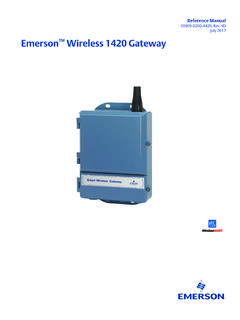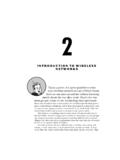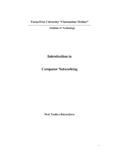Transcription of Understanding Millimeter Wave Wireless Communication
1 L1104-WP Understanding Millimeter Wave Wireless Communication Prasanna Adhikari VP of Business Development for Network Solutions Loea Corporation, San Diego 2008 Loea Corporation Millimeter Wave Wireless Communication White Paper L1104-WP 2008 Loea Corporation 1 introduction With end users ranging from corporate data centers to teenagers with iPhones demanding higher bandwidth, the demand for newer technologies to deliver this bandwidth is higher than ever before. A plethora of technologies exist for the delivery of bandwidth, with fiber optic cable considered to be the ultimate bandwidth delivery medium. However, the fiber optics are not unmatched by any means, especially when all economic factors are considered. Millimeter wave Wireless technology presents the potential to offer bandwidth delivery comparable to that of fiber optics, but without the financial and logistic challenges of deploying fiber.
2 This white paper is intended to provide an overview of this new technology, its opportunities as well as its limitations. THE TECHNOLOGY OVERVIEW Millimeter wave generally corresponds to the radio spectrum between 30 GHz to 300 GHz, with wavelength between one and ten millimeters. However, in the context of Wireless Communication , the term generally corresponds to a few bands of spectrum near 38, 60 and 94 GHz, and more recently to a band between 70 GHz and 90 GHz (also referred to as E-Band), that have been allocated for the purpose of Wireless Communication in the public domain. The History Though relatively new in the world of Wireless Communication , the history of Millimeter wave technology goes back to the 1890 s when Bose was experimenting with Millimeter wave signals at just about the time when his contemporaries like Marconi were inventing radio communications.
3 Following Bose s research, Millimeter wave technology remained within the confines of university and government laboratories for almost half a century. The technology started so see its early applications in Radio Astronomy in the 1960 s, followed by applications in the military in the 70 s. In the 80 s, the development of Millimeter -wave integrated circuits created opportunities for mass manufacturing of Millimeter wave products for commercial applications. In the 1990 s, the advent of automotive collision avoidance radar at 77 GHz marked the first consumer-oriented use of Millimeter wave frequencies above 40 GHz. In 1995, the FCC (US Federal Communications Commission) opened the spectrum between 59 and 64 GHz for unlicensed Wireless Communication , resulting in the development of a plethora of broadband Communication and radar equipment for commercial application. In 2003, the FCC authorized the use of 71-76 GHz and 81-86 GHz for licensed point-to-point Communication , creating a fertile ground for new of industries developing products and services in this band.
4 Figure 1: Bose Demonstrating Millimeter Wave in 1897 The Band and the Bandwidth In the US, four bands in the upper Millimeter wave region have been opened for commercial applications. Of the four bands, the 59-64 GHz band (commonly referred to as V-band or the 60 GHz band) is governed by FCC Part 15 for unlicensed operations. The regulations of FCC Part 15 and the significant absorption of the 60 GHz band by atmospheric oxygen makes this band better suited for very short range point-to-point and point-to-multipoint applications. The 92-95 GHz band (commonly referred to as W-band or the 94 GHz band) is also governed by the FCC Part 15 regulations for unlicensed operation, though for indoor applications only. The 94 GHz band may also be used for licensed outdoor applications for point-to-point Wireless Communication per FCC Part 101 regulations. However the band is less spectrally efficient than the other three bands due to an excluded band at GHz.
5 This leaves 71-76 GHz and 81-86 GHz (commonly referred to as E-band or the 70 GHz and 80 GHz bands, respectively), whose use in the US is governed by FCC Part 101 for licensed operation, as the most ideally suited Millimeter wave band for point-to-point Wireless Communication applications. With the 5 GHz of Millimeter Wave Wireless Communication White Paper L1104-WP 2008 Loea Corporation 2 spectrum available in each of these two bands, the total spectral bandwidth available exceeds that of all allocated bands in the microwave spectrum. Through the remainder of this paper, we confine our discussion to these two bands. The 5 GHz of spectrum available in each sub-band of the E-band spectrum can be used as a single, contiguous transmission channel (which means no channelization is required), thereby allowing the most efficient use of the entire band. Even with simple modulation techniques such as OOK (On-Off-Keying) or BPSK (Binary Phase Shift Keying), throughput of 1to3 Gbps is achieved today in each sub-band of the spectrum, more that what can be achieved with more sophisticated, higher order modulation schemes in other bands of licensed spectrum.
6 Migrating to such modulation techniques at E-band, even higher throughputs can be achieved. It is only a matter of sufficient market demand before such higher throughput Millimeter wave links become a commercial reality. Propagation Characteristics Radio signals of all types, as they propagate through the atmosphere, are reduced in intensity by constituents of the atmosphere. This attenuating effect, usually in the form of absorption or scattering of the radio signals, dictates how much of the transmitted signal actually makes it to a cooperative receiver and how much of it gets lost in the atmosphere. The atmospheric loss is generally defined in terms of decibels (dB) loss per kilometer of propagation. Since the fraction of the signal lost is a strong function of the distance traveled, the reader should note that the actual signal loss experienced by a specific Millimeter wave link due to atmospheric effects depends directly on the length of the link.
7 The propagation characteristics of Millimeter waves through the atmosphere depend primarily on atmospheric oxygen, humidity, fog and rain. The signal loss due to atmospheric oxygen, although a source of significant limitation in the 60 GHz band, is almost negligible less than per km in the 70 and 80 GHz bands. The effect of water vapor, which varies depending on absolute humidity, is limited to between zero and about 50% loss per km (3dB/km) at very high humidity and temperature. The additional loss of signal as it propagates through fog or cloud is similar to the loss due to humidity, now depending on the quantity and size of liquid water droplets in the air. Though 50% loss of signal due to these atmospheric effects may seem significant, they are almost insignificant compared to losses due to rain, and are only important for long distance deployments (more than 5 km) Table 1: Signal Loss through Atmosphere Effect Comments Signal Loss (dB/km) Oxygen Sea Level Humidity 100% at 30 C Heavy Fog 10 C, 1 gm/m3 (50m visibility) Cloud Burst 25 mm/hr rain Of all atmospheric conditions, rain causes the most significant loss of 70 GHz and 80 GHz signal strength, as is the case with microwave signals as well.
8 The amount of signal loss due to rain depends on the rate of rainfall, often measured in terms of millimeters per hour. Table 1 provides a summary of various rain rates and the corresponding amount of attenuation of Millimeter wave signals per kilometer of propagation. The reader should note that 10 dB of loss over 1 km of propagation also means 20 dB of loss over 2 km of propagation Table 2: Signal Loss Due to Rain Description Rain Rate Signal Loss (dB) per km Light Rain 1 mm/hour Moderate Rain 4 mm/hour Heavy Rain 25mm/hour Intense Rain 50 mm/hour From Table 2, one may come to the conclusion that, because of severe attenuation due to rain, Millimeter wave Wireless links are not reliable for deployments likely to experience rain. However, such conclusions are not well founded. Millimeter wave links can indeed perform flawlessly year after year without disruption, even in the presence of occasional downpours in excess of 100 mm/hour.
9 The actual performance of a Millimeter wave link depends on several factors, in particular the distance between radio nodes and the link margin of the radios, and sometimes includes additional factors such as diversity of redundant paths. PERFORMANCE RELIABILITY The performance reliability of a Communication system is often benchmarked in terms of percent (%) availability of the system or the service it offers. The percentage availability signifies the average percentage of the time the system is expected to operate to its specification, , to be available. Millimeter Wave Wireless Communication White Paper L1104-WP 2008 Loea Corporation 3 As stated before, there are other factors that dictate the performance of a Millimeter wave link. An intense rain event may cause significant attenuation of Millimeter wave signals, but it may not cause an outage of a Millimeter wave data link if the link has sufficient margin.
10 Whether or not a link has sufficient margin to overcome an outage due to intense rain depends on the technical specification of the product (for instance transmit power, receive sensitivity, and beam divergence) as well as the distance of the Communication link. The availability of a link also depends on the probability of occurrence of sufficiently heavy rain to cause an outage. For example, in the southwestern US where the probability of rainfall rates exceeding 100 mm per hour is virtually zero, the availability of a 2 km link may be However, the availability of the same 2 km link may be less than in the southeastern US where rain rates exceeding 100 mm per hour are more common. Therefore, the percentage availability of a Millimeter wave link is inherently tied to the rainfall characteristics of the location where the link is deployed, as well as its path length. The characteristics of rainfall throughout the world have been well studied by various organizations.





